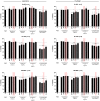Evaluation of Porcine Versus Human Mesenchymal Stromal Cells From Three Distinct Donor Locations for Cytotherapy
- PMID: 32435248
- PMCID: PMC7218165
- DOI: 10.3389/fimmu.2020.00826
Evaluation of Porcine Versus Human Mesenchymal Stromal Cells From Three Distinct Donor Locations for Cytotherapy
Abstract
Background: Mesenchymal stromal cell (MSC)-based cytotherapies fuel the hope for reduction of chronic systemic immunosuppression in allotransplantation, and our group has previously shown this capability for both swine and human cells. MSCs harvested from distinct anatomical locations may have different behavior and lead to different outcomes in both preclinical research and human trials. To provide an effective reference for cell therapy studies, we compared human and porcine MSCs from omental fat (O-ASC), subcutaneous fat (SC-ASC) and bone marrow (BM-MSC) under rapid culture expansion with endothelial growth medium (EGM). Methods: MSCs isolated from pigs and deceased human organ donors were compared for yield, viability, cell size, population doubling times (PDT), surface marker expression and differentiation potential after rapid expansion with EGM. Immunosuppressant toxicity on MSCs was investigated in vitro for four different standard immunosuppressive drugs. Immunomodulatory function was compared in mixed lymphocyte reaction assays (MLR) with/without immunosuppressive drug influence. Results: Human and porcine omental fat yielded significantly higher cell numbers than subcutaneous fat. Initial PDT was significantly shorter in ASCs than BM-MSCs and similar thereafter. Viability was reduced in BM-MSCs. Porcine MSCs were positive for CD29, CD44, CD90, while human MSCs expressed CD73, CD90 and CD105. All demonstrated confirmed adipogenic differentiation capacity. Cell sizes were comparable between groups and were slightly larger in human cells. Rapamycin revealed slight, mycophenolic acid strong and significant dose-dependent toxicity on viability/proliferation of almost all MSCs at therapeutic concentrations. No relevant toxicity was found for Tacrolimus and Cyclosporin A. Immunomodulatory function was dose-dependent and similar between groups. Immunosuppressants had no significant adverse effect on MSC immunomodulatory function. Discussion: MSCs from different harvest locations and donor species differ in terms of isolation yields, viability, PDT, and size. We did not detect relevant differences in immunomodulatory function with or without the presence of immunosuppressants. Human and pig O-ASC, SC-ASC and BM-MSC share similar immunomodulatory function in vitro and warrant confirmation in large animal studies. These findings should be considered in preclinical and clinical MSC applications.
Keywords: adipose-derived stromal cells; bone marrow stromal cells; endothelial growth medium; immunomodulation; immunosupressants; mixed lymphocyte reaction; omentum majus; transplantation.
Copyright © 2020 Schweizer, Waldner, Oksuz, Zhang, Komatsu, Plock, Gorantla, Solari, Kokai, Marra and Rubin.
Figures







Similar articles
-
Viability, yield and expansion capability of feline MSCs obtained from subcutaneous and reproductive organ adipose depots.BMC Vet Res. 2021 Jul 15;17(1):244. doi: 10.1186/s12917-021-02948-0. BMC Vet Res. 2021. PMID: 34266445 Free PMC article.
-
Iberian pig mesenchymal stem/stromal cells from dermal skin, abdominal and subcutaneous adipose tissues, and peripheral blood: in vitro characterization and migratory properties in inflammation.Stem Cell Res Ther. 2018 Jul 4;9(1):178. doi: 10.1186/s13287-018-0933-y. Stem Cell Res Ther. 2018. PMID: 29973295 Free PMC article.
-
Same or not the same? Comparison of adipose tissue-derived versus bone marrow-derived mesenchymal stem and stromal cells.Stem Cells Dev. 2012 Sep 20;21(14):2724-52. doi: 10.1089/scd.2011.0722. Epub 2012 May 9. Stem Cells Dev. 2012. PMID: 22468918 Review.
-
Comparative analysis of the immunomodulatory capacities of human bone marrow- and adipose tissue-derived mesenchymal stromal cells from the same donor.Cytotherapy. 2016 Oct;18(10):1297-311. doi: 10.1016/j.jcyt.2016.07.006. Cytotherapy. 2016. PMID: 27637760
-
The potential role of genetically-modified pig mesenchymal stromal cells in xenotransplantation.Stem Cell Rev Rep. 2014 Feb;10(1):79-85. doi: 10.1007/s12015-013-9478-8. Stem Cell Rev Rep. 2014. PMID: 24142483 Free PMC article. Review.
Cited by
-
Isolation and characterization of farm pig adipose tissue-derived mesenchymal stromal/stem cells.Braz J Med Biol Res. 2022 Dec 2;55:e12343. doi: 10.1590/1414-431X2022e12343. eCollection 2022. Braz J Med Biol Res. 2022. PMID: 36477953 Free PMC article.
-
Identification of Key Genes Associated With Early Calf-Hood Nutrition in Subcutaneous and Visceral Adipose Tissues by Co-Expression Analysis.Front Vet Sci. 2022 May 10;9:831129. doi: 10.3389/fvets.2022.831129. eCollection 2022. Front Vet Sci. 2022. PMID: 35619603 Free PMC article.
-
Characterization of Human, Ovine and Porcine Mesenchymal Stem Cells from Bone Marrow: Critical In Vitro Comparison with Regard to Humans.Life (Basel). 2023 Mar 6;13(3):718. doi: 10.3390/life13030718. Life (Basel). 2023. PMID: 36983873 Free PMC article.
-
Identifying Key Genes and Functionally Enriched Pathways of Diverse Adipose Tissue Types in Cattle.Front Genet. 2022 Feb 14;13:790690. doi: 10.3389/fgene.2022.790690. eCollection 2022. Front Genet. 2022. PMID: 35237299 Free PMC article.
-
Morphological and Molecular Features of Porcine Mesenchymal Stem Cells Derived From Different Types of Synovial Membrane, and Genetic Background of Cell Donors.Front Cell Dev Biol. 2020 Dec 9;8:601212. doi: 10.3389/fcell.2020.601212. eCollection 2020. Front Cell Dev Biol. 2020. PMID: 33363158 Free PMC article.
References
Publication types
MeSH terms
LinkOut - more resources
Full Text Sources
Other Literature Sources
Research Materials
Miscellaneous

